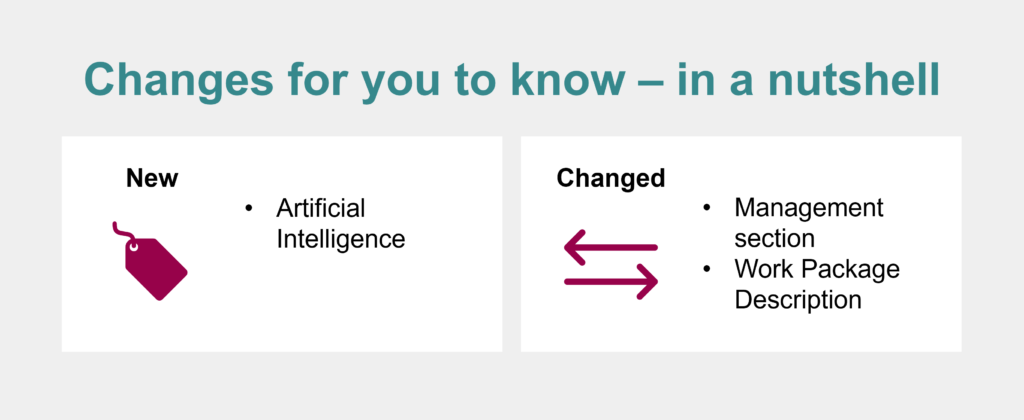MSCA Doctoral Networks 2022 call – important changes in the new proposal template
19th May 2022 at 3:10 pm
The 2022 call for the Marie Sklodowska-Curie Actions (MSCA) Doctoral Networks (DN) has been open for submission since last week. We had a look at the updated MSCA Work Programme, the Guide for Applicants and the updated Standard Proposal Template to see what has changed to the 2021 call.

Back to the roots – simplified secondment rules for Industrial Doctorates (DN-ID) and Joint Doctorates (DN-JD)
One of the most significant changes to the 2021 DN call is the revised secondment rule for DN-IDs and DN-JDs. In standard DN projects, PhD candidates must not spend more than one third of their fellowship on secondment. In the 2021 call, this rule also applied to the DN-IDs and DN-JDs. To meet the specific rules of these modes, it was thus necessary to explore split recruitments between partners for one PhD project. This year, the secondment rule does not apply to DN-IDs and DN-JDs anymore. This decision from the MSCA significantly simplifies the planning and implementation, making them more attractive.
Nevertheless, beneficiaries should be aware of specific employment rules before committing to the single recruitment solution in DN-IDs or DN-JDs. Many institutions have rules in place that forbid long secondments. In addition, national laws may also complicate things. If you plan to apply for a DN-ID or DN-JD, make sure you are aware of all of these aspects, as such decisions seriously impact the project budget.
No more Steering Board
In the 2021 call, the Work Programme required a Steering Board for the network, while the Proposal Template asked for a Supervisory Board. The FAQ section of the call topic further specified that while the two boards should both include members from all network partners, including associated partners, they should have different functions. This made it necessary to include a complicated management structure to follow all guidelines. Fortunately, the MSCA has since removed the Steering Board for the 2022 proposals. We always recommend keeping the management structure of DNs reasonably lean, as these projects may otherwise suffer under over-administration or the bodies never end up being properly implemented, which can cause issues in the long term.
Significant changes to the proposal Part B
First things first, Part B of the proposal still has to be submitted in two documents and the page limit of 34 pages (30 only counting the actual core proposal) still only applies to Part B1. There are, however, some interesting changes in Part B1 and Part B2 that applicants should be aware of, especially if resubmitting a 2021 DN proposal.
| Item | 2021 | 2022 |
| Work Packages table | Table 1.1 in the Excellence. | Table 3.1a in the Implementation. |
| Recruitment Table per Beneficiary | Table 1.3a ‘ Recruitment Deliverables per Beneficiary’ in Excellence. | Table 3.1e in Implementation. Mind the new table heading. |
| Artificial Intelligence | n/a | New required sub-heading in section 1.2 Methodology. Can be removed if not applicable. |
| Work Package Description | Table 3.1a | Table 3.1b, no description of deliverables necessary anymore (remove). |
| Deliverables List | Table 3.1b | Table 3.1c, include new column for short description of deliverable. |
| Network organisation | Section 3.1.5 (Part B1), required sub-heading. | Section 4 (Part B2). |
| Joint governing structure | Section 3.1.6 (Part B1), required sub-heading for DN-IDs and DN-JDs. | To be addressed, for DN-IDs and DN-JDs, as part of section 4 in Part B2 (see also Network organisation). |
| Gender aspects | Section 3.1.12 | To be addressed under required sub-headings ‘Supervisory Board’ and ‘Recruitment Strategy’ respectively |
| Steering Board | To be addressed in ‘Netowrk organisation’ or ‘Joint governing structure’ in section 3.1. | Not applicable anymore. Roles and Responsibilities should be integrated and revised together with the ‘Supervisory Board’ (section 3.1.8). |
| Environmental aspects in light of the MSCA Green Charter | Section 3.1.13 (Part B1) | Section 5 (Part B2) |
| Participating Organisations | Section 4 (Part B2) | Section 6 (Part B2), no other changes. |
| Letters of Commitment | Section 5 (Part B2) | Section 7 (Part B2), no other changes. |
Part A remains unchanged
Part A of the proposal remains unchanged so far. To save efforts, be aware that beneficiaries and associated partners still do not need to fill the lists of publications, previous projects and infrastructure in Part A, as all of these are to be listed in the participant descriptions in section 6 of Part B2. Information about the researchers involved also does not have to be provided in Part A for any associated partners.
Starting your Doctoral Networks proposal journey
Are you planning to submit a DN proposal to this year’s call? Ensure that you have all the necessary documents ready, and regularly check the call on the Funding & Tenders Portal for important updates. We regularly publish blog posts on Doctoral Networks and many other Horizon Europe and funding topics. You can subscribe to our blog updates on our blog main area.
As an associated partner in four newly funded Horizon Europe DNs and many successful Innovative Training Networks (ITNs) funded under Horizon 2020, we at accelopment have gathered a great deal of practical experience in Proposal Writing, Project Management and Dissemination support as well as Transferable Skills Training all geared toward DNs. If you are interested in our support for your upcoming DN proposal, feel free to contact us. Also, check out our Transferable Skills Online Modules to complement your training programme.

Jacqueline Strehler
Research & Innovation Project Manager
